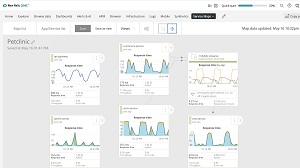News
Java on Azure: Azure Spring Cloud Integrates with New Relic One Performance Monitoring
Microsoft's Java on Azure team announced the integration of New Relic One performance monitoring in Azure Spring Cloud, used to deploy Spring Boot–based microservice applications to Azure.
The integration arose from work with enterprise customers migrating their on-premises Spring Boot applications to the cloud, seeking to use familiar application performance monitoring (APM) tools. Spring Boot is part of the Spring Framework, a comprehensive programming and configuration model for modern Java-based enterprise applications. Spring Boot eases the creation of stand-alone, production-grade Spring-based applications.
Another benefit of the integration is ensuring continuity for desktop and mobile applications that are already pre-instrumented for end-to-end monitoring using agents such as New Relic One, Microsoft said.
 [Click on image for larger view.] Monitoring All Applications in a Project (source: Microsoft).
[Click on image for larger view.] Monitoring All Applications in a Project (source: Microsoft).
"New Relic One Navigator offers you an at-a-glance view of the operational health of your application instances," Microsoft said in a July 1 blog post. "This bird's eye view of your estate is automatically available to you, no configuration required. Navigator makes it easy for you to explore huge numbers of instances as it intuitively displays your instances in a dense honeycomb view with traffic light colors based on alerts that you define. Quickly identify alerting instances and uncover root causes in addition to seeing which dependent systems might be affected."
That at-a-glance view is attained after developers first instrument their Spring Boot applications via "provisioning automation" with tools such as Terraform or ARM Template, or via an on-demand command entered through the Azure CLI (command-line interface). Then the New Relic One portal can be used to monitor applications, Java Virtual Machines (JVM), transactions and more, helping with the identification and troubleshooting of performance issues.
"Azure Spring Cloud is jointly built, operated, and supported by Microsoft and VMware," the post stated. "It is a fully managed service for Spring Boot applications that abstracts away the complexity of infrastructure and Spring Cloud middleware management, so you can focus on building your business logic and let Azure take care of dynamic scaling, patches, security, compliance, and high availability. With a few steps, you can provision Azure Spring Cloud, create applications, deploy, and scale Spring Boot applications, and start monitoring in minutes. We will continue to bring more developer-friendly and enterprise-ready features to Azure Spring Cloud."
About the Author
David Ramel is an editor and writer at Converge 360.